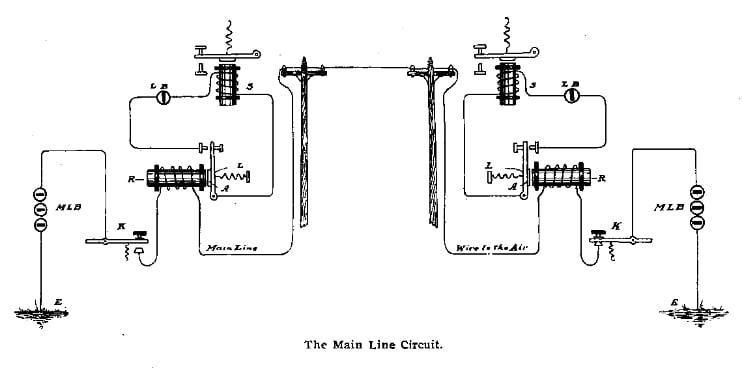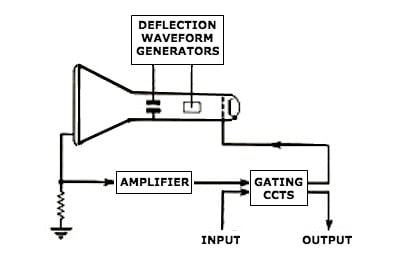1844: Samuel Morse Sends First Electrical Telegraph Message in USA
On May 24, 1844, Samuel Morse sent the first electric telegraph message in the USA: “What hath God wrought”. The message traveled from Washington DC to Baltimore and brought forth the age of the electric telegraph. Morse would also invent Morse Code, which represented the alphabet with a series of dots and dashes (short beeps and long beeps). The electric telegraph would revolutionize communication across the world, allowing people to communicate quickly from vast distances. In the 1800s, this was groundbreaking.
The machine that received the "What hath God wrought" message in 1884. Image from Early History of the Electro-Magnetic Telegraph by Alfred Vail via Princeton University.
However, before Morse’s invention, there had been other attempts at electronic telegraphy. From 1753 to the early 1800s various attempts at electric, or electric chemical, methods of telegraphy were attempted. Some designed involved electrostatic machines which moved pith balls to indicate which letter was being transmitted, deflecting compass needles with current, or using vials of chemicals that would bubble to indicate a letter transmission. Up until this point, most systems were impractical or had too short of a range to be useful.
It wasn’t until the early 1800s when functional and theoretically practical electrical telegraphy systems would be invented along with binary systems of messaging. Messaging over increasingly greater distances would begin to be achieved, and early forms of telegraph networks would be built in Munich.
Finally, in 1837 Samuel Morse invented the recording electric telegraph, which would imprint the morse message onto a paper tape. The Morse messaging system would become widely adopted, and electrical telegraphy would be a popular form of long-distance communication until the telephone.

A basic diagram of the original Main Line Circuit. Image courtesy of Telegraph Lore.
The diagram above is a high-level view of the Morse circuit. The instruments used to operate a telegraph circuit were known as the key, the Morse relay, and the sounder. The transmitter was an electrical switch with a pair of contacts that could be manually manipulated to create or break the circuit in a pattern to convey messages in Morse code. The relay was a sensitive electromechanical amplifier using a horseshoe electromagnet. The relay's contacts connected to the local circuit or sounder. The sounder acted as a receiver and would produce clicking noises when its electromagnet was energized to communicate Morse code to a listener. Two batteries provided power: a main battery made of multiple electrochemical cells (could be several hundred volts) and a local single-cell battery (usually only 1 to 1.5 volts) for the sounder.
The line, itself, was galvanized iron wire that used glass insulators to reduce leakage and allow telegraph transmission even in wet weather.
This circuit is significant because it arguably represents the moment that telegraph technology became truly viable and allowed it to spread and thrive. Telegraphy's beginnings were in the 19th century (and its use actually carried into the 21st century) but Morse's "What hath God wrought" message opened the door to an era in the mid-1800s that changed communications forever.
1954: The IBM 704 Mainframe Computer Uses Core Memory (and Inspires HAL 9000 in 1962)
The IBM 704 is the basis for some of the most significant moments in computing history, including being the system that LISP and FORTRAN were developed on. The big deal about the IBM 704 was that it was capable of floating-point arithmetic (up to 12,000 floating-point additions per second), making it particularly suited for complex mathematics.It was with the 704 that IBM also made a historic transition from Williams-tube electrostatic storage devices (based on cathode ray tubes) to core memory. This made the 704 faster than its predecessor, the 701.

A simple diagram of a cathode ray tube. Image courtesy of and adapted from the University of Amsterdam.
Programs for the IBM 704 would be input first into the system using punch cards. The programs of the punch cards could then be recorded on magnetic tape or be directly processed.
The IBM 704 was important in terms of applications, as well. In 1957, an engineer at Bell Telephone Laboratories, Max Mathews, used the 704 to create 17 seconds of music on a computer for the first time in history. In 1962, John Larry Kelly, Jr. (along with Max Mathews) used the 704 in the original development of speech synthesis—the computer would be given a voice for the first time. A demonstration was given of the IBM 704 singing Daisy Bell.
For sci-fi fans, this song would be made famous by 2001: A Space Odyssey in which HAL 9000 sings the song while being dismantled. This is no coincidence—Arthur C. Clarke happened to be visiting Bell Labs and was present during the speech synthesis demonstrations.
Listen to the 704 sing in the video below:
To see how far talking computers have come in the last 55 years, check out Google Duplex's speech synthesis.
1984: Dell Computers is Founded (in Michael Dell's Dorm Room)
Dell Computers is the classic story of a successful tech company originating out of a keen entrepreneur’s dorm-room. Michael Dell was simultaneously motivated by financial success and his interest in technology. In his teens, he earned $18,000 (roughly $45,000 in 2018) in a year by efficiently finding new customers to sign up for newspaper subscriptions, and ordered an early Apple computer to be able to take it apart.In 1984, Dell began to sell computers through direct-sales under the banner of PC's Limited while he was a pre-med student at the University of Texas at Austin. At first, he bought outdated computers from local stores, upgraded them, and then sold the systems to other students. After his first year of college, he dropped out to continue working on his company with $1000 in capital—Dell would eventually become the youngest CEO of a Fortune 500 company in 1992.

One of PC's Limited Magazine ads. Image courtesy of the Daily WTF.
In 1974, the company renamed itself to Dell Computers and began to expand globally. It would become one of the largest computer companies in the world, would expand into other electronics, and become the staple of nearly every business.






No comments:
Post a Comment